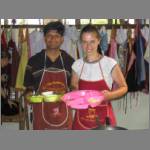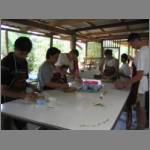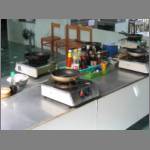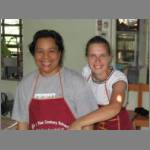



Our stay on the beach of Ao Nang in
Krabi province was exceptionally nice because
we got to do two activities that we enjoy
a lot: kayaking and
cooking. This blog concerns itself only with our glorious learning
experience at the Krabi Thai Cookery School run
by the friendly, cheerful chef Chonlaya
Laotong, better known as Ya. We spent half a day in her efficient
kitchen, training to make 4 different kinds of
curry paste, several curry chicken dishes,
hot and sour "tom
yam" soup, chicken in coconut milk soup "tom kha kai", Thai-style
fried noodles
"pad thai" and the tasty sour salad of green papaya. See my earlier
comments
on
Thai
food and drinks for more details.
The multitude of dishes was all prepared from scratch, meaning you get to chop up all ingredients first. The Thais are very particular about presentation of their food, so simply chopping all the veggies into uneven-sized chunks will never do. The simplest thing expected of you would be to chop the pumpkin into equal-sized cubes, each comfortably fitting into the soup spoon. More advanced techniques include carving grooves in the surface of eggplant and then slicing it, so you end up with star-shaped chunks. Lemongrass has to be cut diagonally to arrive at U-shaped oblong slices. And these knife-skill exercises are nothing compared with fruit carving, which is a special art within Thai cooking tradition and requires a special class (which we did not have time to take).
After chopping comes the actual stovetop cooking, which proved to be surprisingly easy and quick. No dish took longer than 15 minutes on the stove, which makes them perfect candidates for a weekday after-work dinner. The preparation is so straight forward that it's hard to mess up any given dish, provided you follow the simple recipe (no more than 10 ingredients to a dish, including salt). Some items used in Thai cuisine may be a bit hard to find back home, but substitues are available (orange peel if you cannot find bergamot, lemon juice instead of tamarind, etc). Dishes can be prepared with meat (chicken, pork, beef), seafood (fish, prawns), or vegetarian. Any way you do it, it comes out very tasty! And in home conditions, you are free to make the food only as spicy as you can handle, while ordering in restaurants in Thailand often results in something quite a bit hotter than you'd prefer (even if you say "Not spicy please" clearly and loudly). Chillies are endemic to Thai cuisine, but they only provide the heat, while other less fiery spices supply the yummy flavours.
When I try my hand at making Thai dishes back home,
I shall place a fire extinguisher within reach
when "pad thai" is on the menu. When Ya asked
for volunteers to prepare "pad thai" in class,
I eagerly jumped out and confidently responded
that it's okay to her question whether I might
be afraid of fire. What's there to be afraid
of, I thought to myself, didn't I just make a
perfectly palatable pumpkin curry on the stovetop
without any issues? Well, it turned out that
cooking "pad thai" is a completely different
story from that innocuous curry. This dish involves
frying noodles (already cooked) in a generous
amount of oil, and shifting the frying pan on
the stove results in three-feet-high flames suddenly
flaring up in front of you! I was terrified when
this first happened, but soon learned to hold
the hot pan handle and shake up the contents
without burning myself while still entertaining
the spectators with the fire show. The resulting
dish (which includes, in addition to noodles,
fried egg, bean sprouts and peanuts) was very
tasty, but a bit on the oily side, so maybe I'll
try a safer, less oily version of it at home,
which will incidentally be less likely to go
up in flames.
Above: mis-en-place stage. First Ya explains the recipes to work with, then we chop and carve, finally - the stoves await!
Below: Puneet's progress from apprentice to an accomplished Thai cook.
Above: Daria's "chicken in red curry with pumpkin". Below: trial by fire, a.k.a. making "Pad Thai" noodles.